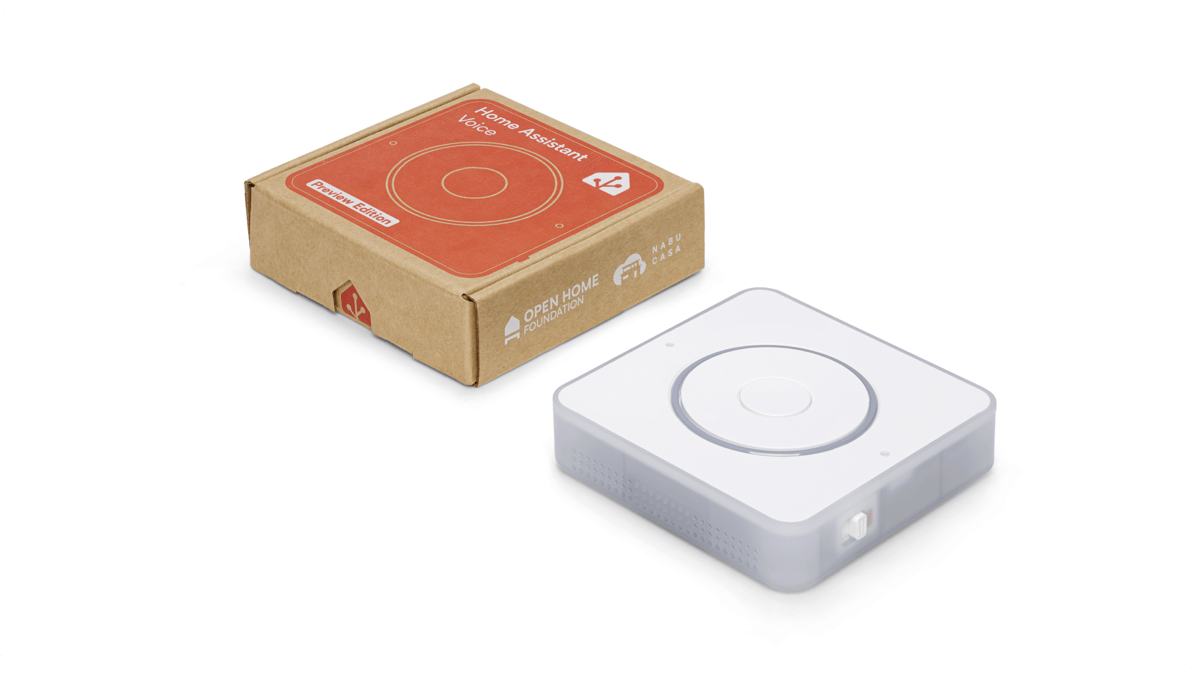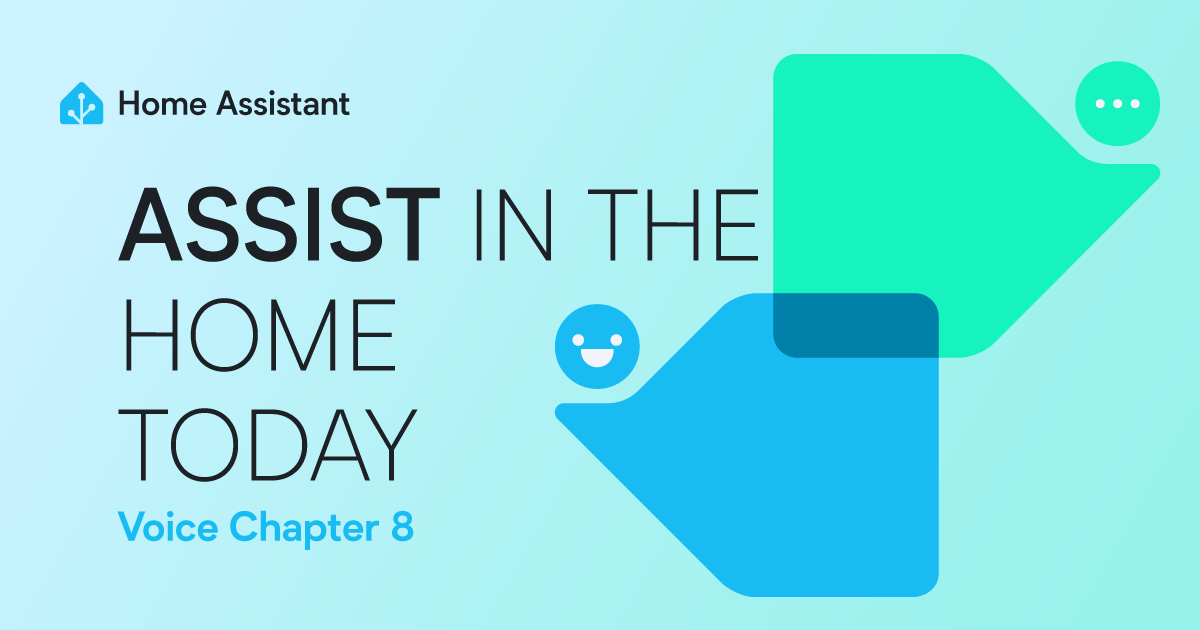Blog
Apollo joins the Works With Home Assistant Program

Apollo Automation
Notably, these are the first ESPHome
Speech-to-Phrase brings voice home - Voice chapter 9
Welcome to Voice chapter 9 🎉 part of our long-running series following the development of open voice.
We’re still pumped from the launch of the Home Assistant Voice Preview Edition at the end of December. It sold out 23 minutes into our announcement - wow! We’ve been working hard to keep it in stock at all our distributors.
Today, we have a lot of cool stuff to improve your experience with Voice PE or any other Assist satellite you’re using. This includes fully local and offline voice control that can be powered by nearly any Home Assistant system.
- Voice for the masses
- Building an Open Voice Ecosystem
- Large language model improvements
- Expanding Voice Capabilities
- Home Assistant phones home: analog phones are back!
- Wyoming improvements
- 🫵 Help us bring choice to voice!
2025.2: Iterating on backups
Home Assistant 2025.2! ❤️
In the previous release, we overhauled our backup system, and the response was overwhelming! Tons of suggestions and feature requests came in, so this release is—once again—focused on backups. Based on this community feedback, we’ve added loads of improvements, including the first integrations to store your backups in Google Drive and Microsoft OneDrive!
This release also brings exciting new features to Voice! Home Assistant can now call your analog phone, and when dinner is ready, you can broadcast that message to all voice assistants in your home! But wait… there’s more!
On February 12, 2025, we’re streaming live on YouTube all about Voice:
Voice - Chapter 9
Before diving into the release notes, I also want to give a shoutout to our
friends at ESPHome
Enjoy the release!
../Frenck
PS: It is almost Valentine’s day, did you set up some romantic scenes yet? 🌹
Read on →3…2…1… Backup

Home Assistant is a powerful tool that can save you time and money by automating your home. Pretty important things around the home, from heating to an automatic fish feeder, need to depend on it. However, as your setup grows more complex, maintaining it—what we call “digital housekeeping”—can become a time-consuming task. Backups are a critical part of this maintenance, yet they’re often overlooked, especially by new users, often until it is too late when disaster strikes.
To make backups effortless, we’ve introduced new automated and off-site backup features in the latest release of Home Assistant. These improvements will make it easier than ever to safeguard your setup. As we step into the New Year, we would encourage you to adopt a simple yet crucial resolution: regularly back up your data. With our new tools, it takes just five minutes to set up and provides lasting peace of mind.
Learn more about our backups below, or get started now by updating and visiting the backups page.
Read on →2025.1: Backing Up into 2025!
Home Assistant 2025.1! 🥂
Happy New Year! The whole Home Assistant project wishes you and your loved ones a fantastic and healthy 2025! ❤️ Let’s make this year even better than the last!
We are all super excited to kick off the new year with an absolute massive release! 🎆
This release brings a complete overhaul of the backup system in Home Assistant, which has been in the works for months! And I’m not just talking about some user interface changes—no, we are talking about a complete overhaul from front to back!
Automated backups, encrypted Home Assistant Cloud backup storage, retention policies, configuration wizards, and even the ability for integrations to offer backup storage locations! 🤯
But that is not all! We also had the Month of “What the Heck?!” in December, which resulted in a lot of quality-of-life improvements raised by the community that month!
There is so much to unwrap in this release, seriously, let’s just dive in!
Enjoy the release!
../Frenck
Read on →The era of open voice assistants has arrived
TL;DR: Check out the product page
We all deserve a voice assistant that doesn’t harvest our data and arbitrarily limit features. In the same way Home Assistant made private and local home automation a viable option, we believe the same can, and must be done for voice assistants.
Since we began developing our open-source voice assistant for Home Assistant, one key element has been missing - great hardware that’s simple to set up and use. Hardware that hears you, gives you clear feedback, and seamlessly fits into the home. Affordable and high-quality voice hardware will let more people join in on its development and allow anyone to preview the future of voice assistants today. Setting a standard for the next several years to base our development around.

We’re launching Home Assistant Voice Preview Edition to help accelerate our goal of not only matching the capabilities of existing voice assistants but surpassing them. This is inevitable: They’ll focus their efforts on monetizing voice, while our community will be focused on improving open and private voice. We’ll support the languages big tech ignores and provide a real choice in how you run voice in your home.
The era of open, private voice assistants begins now, and we’d love for you to be part of it.
Table of contents
Read on →Voice Chapter 8 - Assist in the home today

As you have probably already read, we launched our Home Assistant Voice Preview Edition today. The culmination of the past several years of open-source software progress on Home Assistant’s home-grown voice assistant, Assist. A sizable group of dedicated developers has been working together on adding and honing its many features, and if it’s been a while since you tried Assist, you should use this launch as a chance to jump back in and see the progress we’ve made.
Home Assistant Voice Preview Edition has been launched to build on this work, continuing the momentum we’ve already built and accelerating our goal of not only matching the capabilities of existing voice assistants but surpassing them. We had an early production run of Voice Preview Edition (a preview preview 😉), and we tried to get them in the hands of as many of our language leaders and voice developers as possible - and we’re already seeing the fruits of their efforts with language support improving over the past month alone!
I’d like to highlight in this voice chapter all the things you can do with Assist today. I also want to give the state of our development, what the limitations are, and where your support can be best applied.
Table of Contents
Read on →Understanding Our Community: The 2024 Home Assistant Survey

As Home Assistant continues to grow and evolve, so does our commitment to making it more inclusive, accessible, and aligned with the diverse needs of our community. To that end, we’re launching an annual survey—and we hope you’ll participate!
A big part of building our roadmap going forward was focusing more on research, which led the team to bring me (Annika) in as a Senior User Experience Researcher. We could keep assuming our community’s wants and needs, but we’d rather base our decisions on data-driven insights 😉. With this survey, we aim to better understand not just how you use Home Assistant, but also who you are as a person, a smart home user, and a member of our community. This knowledge will help us:
- Tailor our future work to address the needs of our community.
- Identify trends and shifts in the smart home landscape over time.
- Ensure Home Assistant and its ecosystem reflect the values and priorities of those who use it.
We understand that some of the questions we’re asking touch on sensitive topics. Rest assured, your responses are completely anonymous, and all questions are optional. If you’re ever uncomfortable, you can skip a question—but for the results to be recorded, you must hit the submit button at the end of the survey. This survey isn’t short; we recommend setting aside around 20 minutes to complete it. Fill out the survey here
~Annika
Read on →2024.12: Scene you in 2025! 🎄
Home Assistant 2024.12! 🎄
Holidays are coming, and it is time for the last release of the year! 🎉
2024 has been a crazy year for Home Assistant. Not just in terms of features
like drag-and-drop dashboards, organization capabilities like labels, and
the countless improvements to our voice efforts. But also the founding of
the Open Home Foundation
However, the year ain’t over yet! This month, we want to learn about all your “What the heck?!” moments with Home Assistant. Tell us about any little annoyances, bugs, ideas, or suggestions. You can read all about it in the WTH announcement blog, or join the conversation on our WTH forums!
Honestly, the biggest announcement of the year has yet to come though… 🤫
I’m pretty sure it is voice hardware related. 😉 So make sure you aren’t
missing the live stream on 19 December
Before you check out everything in this release, I just want to close this year with a big thank you to every single person in our community, which includes you!
Thank you for using Home Assistant! ❤️
Happy holidays! And for the last time in 2024: Enjoy the release!
../Frenck
Read on →The month of 'What the Heck?!' 2024
TL;DR: For all of December 🎄, we are opening up to share any issue, idea, suggestion, or annoyance you have with Home Assistant on our community forums!
Welcome to the month of “What the heck?!”: Third edition
It’s back! 🎉 We are thrilled to announce the third edition of the month of “What the heck?!” (WTH for short). Every two years, we take the time to pause, listen, and dive deep into the little things that maybe you go “What the heck?!” about Home Assistant.
We’ve been growing really hard for years now with over a million Home Assistant-powered smart homes out there, and, as of this year, we are also the #1 open source project on GitHub!
A lot has happened since the last edition two years ago. Lots of effort went into making a voice-controlled Home Assistant a reality. We have implemented new dashboards and cards (with drag-and-drop!), added organization capabilities with labels and categories, and so much more! But did everything turn out the way it should? Did we miss things? Or, worse, did something start to annoy you?
That is what this month is about! This year, we are kicking it off in the month of December as a nice closing activity for this year, and we can’t wait to hear from 👉 YOU 👈!
Read on →